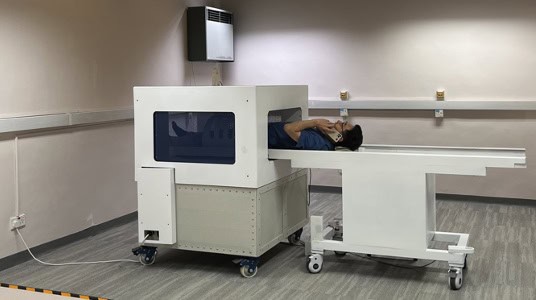
Magnetic resonance imaging (MRI) is an essential tool used by radiologists to visualize tissues and diagnose disease, particularly for brain, cardiac, cancer and orthopaedic conditions. However, the high cost of an MRI scanner and dedicated MR imaging suite, combined with the scanner’s operational complexity, has severely limited its use in low- and middle-income countries, as well as in rural healthcare facilities.
Among member countries of the Organization for Economic Co-operation and Development (OCED), the number of MRI scanners (in 2021) ranged from just 0.24 per million people in Columbia to 55 per million in Japan. This significant disparity negatively impacts the quality of healthcare for the global population.
Aiming to close this gap in MRI availability, researchers at the University of Hong Kong’s Laboratory of Biomedical Imaging and Signal Processing are developing a whole-body, ultralow-field 0.05 T MR scanner that operates from a standard wall power outlet and does not require radiofrequency (RF) or magnetic shielding cages.
Targeted as both an alternative and a supplement to conventional 1.5 T and 3 T MRI systems, the novel scanner incorporates a compact permanent magnet and employs data-driven deep learning for image formation. This simplified design not only makes the MRI scanner easier to operate, but should significantly lower its acquisition and maintenance costs compared with current clinical MRI systems.
Writing in Science, principal investigator Ed X Wu and colleagues describe how they used the 0.05 T scanner, along with deep-learning reconstruction methods developed by the team, to obtain anatomical images of the brain, spine, abdomen and knee with comparable image quality to that of a 3T system. In one example, they acquired spine MRI scans showing details of intervertebral disks, the spinal cord and cerebrospinal fluid, in 8 min or less.
Whole-body scanner design
Central to the scanner’s hardware design is a permanent neodymium ferrite boron (NdFeB) magnet with a double-plate structure. Permanent magnets are safer to operate than superconductive magnets as they generate less heat and acoustic noise during imaging. Ultralow-field MRI also benefits from low sensitivity to metallic implants, fewer image susceptibility artefacts at air–tissue interfaces and an extremely low RF specific absorption rate.
The magnet features two NdFeB plates connected by four vertical pillars, chosen to optimize openness and patient comfort. Its key components – including yokes, magnet plates, pole pieces, anti-eddy current plates and shimming rings – were designed to create a uniform field suitable for whole-body imaging while maintaining shoulder and chest accessibility. The final magnetic field was 0.048 T at room temperature (corresponding to a 2.045 MHz proton resonance frequency).

The magnet assembly has exterior dimensions of 114.0 x 102.6 x 69.9 cm, with a 40 x 92 cm gap for patient entry, and weighs approximately 1300 kg, making it potentially portable for point-of-care imaging.
In the absence of RF shielding, the researchers used deep learning to eliminate electromagnetic interference (EMI). Specifically, they positioned 10 small EMI sensing coils around the scanner and inside the electronics cabinet to acquire EMI signals. During scanning, the EMI sensing coils and the MRI receive coil simultaneously sample data within two windows: one for MR signal acquisition, the other for EMI signal characterization. The team then used a deep-learning direct signal prediction (Deep-DSP) model to predict EMI-free MR signals from the acquired data.
For the study, 30 healthy volunteers were scanned with the 0.05 T system, using standard protocols and optimized contrasts for the various anatomical structures. To overcome the weak MR signal at 0.05 T, the team also designed a data-driven deep-learning image formation method – the partial Fourier super-resolution (PF-SR) model – that integrates image reconstruction and 3D multiscale super-resolution, validating the model by comparing 0.055 T brain scans with 3 T images from the same subjects (as described in Science Advances). This PF-SR reconstruction improved the 0.05 T image quality by suppressing artefacts and noise and increasing spatial resolution.

Ultralow-field MRI scanner could improve global access to neuroimaging
The researchers are currently optimizing the scanner design and algorithms. They plan to perform experimental assessment and optimization of ultralow-field data acquisition and deep-learning image reconstruction, to yield the optimal trade-offs between image fidelity, resolution, contrast, scan time and cost for each specific application. They are also evaluating clinical applications of the 0.05 T scanner in depth.
“We shall continue to refine our data-driven approaches in order to minimize the hardware requirements while advancing imaging quality and speed,” Wu tells Physics World. “We are starting to plan our research of the PF-SR in detecting various pathologies, and are currently training the PF-SR models with datasets from both normal and abnormal subjects.”
- SEO Powered Content & PR Distribution. Get Amplified Today.
- PlatoData.Network Vertical Generative Ai. Empower Yourself. Access Here.
- PlatoAiStream. Web3 Intelligence. Knowledge Amplified. Access Here.
- PlatoESG. Carbon, CleanTech, Energy, Environment, Solar, Waste Management. Access Here.
- PlatoHealth. Biotech and Clinical Trials Intelligence. Access Here.
- Source: https://physicsworld.com/a/researchers-build-0-05-t-mri-scanner-that-produces-diagnostic-quality-images/
- :has
- :is
- :not
- 05
- 1
- 1.3
- 10
- 114
- 1300
- 2021
- 24
- 30
- 300
- 3d
- 40
- 69
- 8
- 9
- a
- abnormal
- absence
- access
- accessibility
- acquire
- acquired
- acquisition
- advancing
- algorithms
- along
- also
- alternative
- an
- and
- Application
- applications
- approaches
- approximately
- ARE
- around
- AS
- Assembly
- assessment
- At
- availability
- benefits
- between
- biomedical
- both
- Brain
- build
- but
- by
- cages
- Cancer
- chosen
- click
- Clinical
- Close
- coil
- colleagues
- COLUMBIA
- combined
- comfort
- compact
- comparable
- compared
- comparing
- complexity
- components
- conditions
- connected
- continue
- contrast
- contrasts
- conventional
- cord
- Corresponding
- Cost
- Costs
- could
- countries
- create
- Current
- Currently
- data
- data-driven
- datasets
- dedicated
- deep
- deep learning
- depth
- describe
- described
- Design
- designed
- details
- developed
- developing
- Development
- diagnostic
- dimensions
- direct
- Disease
- does
- during
- each
- easier
- Economic
- ed
- Electronics
- eliminate
- employs
- entry
- essential
- evaluating
- example
- experimental
- extremely
- facilities
- Features
- fewer
- fidelity
- field
- final
- fluid
- Footprint
- For
- formation
- four
- Frequency
- from
- gap
- generate
- Global
- Global Access
- Hardware
- hardware design
- Have
- healthcare
- healthy
- High
- Hong
- Hong Kong
- How
- However
- HTTPS
- image
- images
- Imaging
- Impacts
- improve
- improved
- in
- Including
- incorporates
- increasing
- information
- inside
- Integrates
- interfaces
- Interference
- issue
- IT
- ITS
- Japan
- jpg
- just
- Key
- Kong
- lab
- learning
- less
- Limited
- Low
- low-cost
- lower
- magnet
- Magnetic field
- Magnets
- Maintaining
- maintenance
- MAKES
- Making
- max-width
- member
- method
- methods
- million
- min
- minimize
- model
- models
- mr
- MRI
- negatively
- Neither
- Noise
- nor
- normal
- novel
- number
- obtain
- of
- ONE
- only
- open
- Openness
- operate
- operates
- operational
- optimal
- optimization
- Optimize
- optimized
- optimizing
- or
- order
- organization
- Other
- our
- outlet
- Overcome
- particularly
- patient
- People
- per
- Perform
- permanent
- Physics
- Physics World
- pieces
- pillars
- plan
- plato
- Plato Data Intelligence
- PlatoData
- population
- portable
- positioned
- potentially
- power
- predict
- prediction
- Principal
- produces
- protocols
- prototype
- quality
- Rate
- receive
- refine
- require
- Requirements
- requires
- research
- researchers
- Resolution
- resonance
- Room
- roughly
- Rural
- safer
- same
- sample
- scan
- scanning
- scans
- Science
- Sensitivity
- severely
- should
- showing
- Signal
- signals
- significant
- significantly
- simplified
- simultaneously
- small
- Spatial
- specific
- specifically
- speed
- standard
- Starting
- structure
- structures
- Study
- suitable
- suite
- supplement
- susceptibility
- system
- Systems
- team
- tells
- than
- that
- The
- then
- they
- this
- thumbnail
- time
- to
- tool
- Training
- true
- two
- university
- use
- used
- using
- validating
- various
- vertical
- visualize
- volunteers
- Wall
- was
- weak
- WELL
- were
- while
- windows
- with
- within
- world
- wu
- X
- Yield
- zephyrnet













